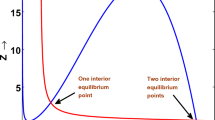Abstract
Phytoplankton is an important indicator organism to evaluate the quality of water environment, which may reflect the nutritional level of the sea area. Conversely, environmental conditions can directly affect the community structure of phytoplankton. A stochastic phytoplankton–zooplankton model considering non-degenerate and degenerate diffusions is formulated in this paper. What’s more, in both systems, we obtain sufficient conditions of extinction and ergodicity. Our results demonstrate that the weaker white noise can ensure the permanence of zooplankton and the stronger white noise can lead to the disappearance of zooplankton. Moreover, the threshold value of extinction and persistence can serve as a theoretical basis for controlling phytoplankton and zooplankton. Numerical examples are performed on the analysis results of the two cases to confirm our theoretical results. In addition, we also provide a real-life case study, the validity of the model is verified based on experimental data, and it is shown that fluctuation of external environment and the consumption of phytoplankton by zooplankton will affect the growth and number of phytoplankton. Effectively controlling the quantity of phytoplankton can delay the occurrence of water bloom or red tide.






Similar content being viewed by others
References
Bao, K., Rong, L., Zhang, Q.: Analysis of a stochastic SIRS model with interval parameters. Discrete Contin. Dyn. Syst. B 24(9), 4827–4849 (2019)
Ben Arous, G., Léandre, R.: Décroissance exponentielle du noyau de la chaleur sur la diagonale (II). Probab. Theory Relat. Fields 90, 377–402 (1991)
Coutinho, M., Brito, A., Pereira, P., et al.: A phytoplankton tool for water quality assessment in semi-enclosed coastal lagoons: open vs closed regimes. Estuar. Coastal Shelf Sci. 110, 134–146 (2012)
Du, N., Nguyen, D., Yin, G.: Conditions for permanence and ergodicity of certain stochastic predator–prey models. J. Appl. Probab. 53(01), 187–202 (2016)
Fogg, G.: The ecological significance of extracellular products of phytoplankton photosynthesis. Bot. Mar. 26(1), 3–14 (1983)
Han, B., Jiang, D., Hayat, T., et al.: Stationary distribution and extinction of a stochastic staged progression AIDS model with staged treatment and second-order perturbation. Chaos Solitons Fractals (2020). https://doi.org/10.1016/j.chaos.2020.110238
Has’miniskii, R.: Ergodic properties of recurrent diffusion processes and stabilization of the Cauchy problem for parabolic equations. Theory Probab. Appl. 5(2), 196–214 (2006)
Havens, K., Elia, A., Taticchi, M., et al.: Zooplankton–phytoplankton relationships in shallow subtropical versus temperate lakes Apopka (Florida, USA) and trasimeno (Umbria, Italy). Hydrobiologia 628(1), 165–175 (2009)
He, S., Tang, S., Cai, Y., et al.: A stochastic epidemic model coupled with seasonal air pollution: analysis and data fitting. Stoch. Env. Res. Risk Assess. 34(1), 2245–2257 (2020)
Higham, D.: An algorithmic introduction to numerical simulation of stochastic differential equations. SIAM Rev. 433, 525–546 (2001)
Ikeda, N., Watanabe, S.: A comparison theorem for solutions of stochastic differential equations and applications. J. Math. 14, 619–633 (1977)
Jassby, D., Platt,T.: Mathematical formulation of the relationship between photosynthesis and light for phytoplankton. Limnol. Oceanogr. (1976)
Khas’minskii, R.: Stochastic Stability of Differential Equations, 2nd edn. Springer, Heidelberg (2012)
Liu, Q., Jiang, D., Hayat, T., et al.: Dynamical behavior of a stochastic model of gene expression with distributed delay and degenerate diffusion. Stoch. Anal. Appl. 36, 584–599 (2018)
Luo, J.: Phytoplankton–zooplankton dynamics in periodic environments taking into account eutrophication. Math. Biosci. 245(2), 126–136 (2013)
Majumder, A., Adak, D., Bairagi, N.: Phytoplankton-zooplankton interaction under environmental stochasticity: survival, extinction and stability. Appl. Math. Model. 89(2), 1382–1404 (2021)
Mao, X.: Stochastic Differential Equations and Applications, 2nd edn. Horwood Publishing, Chichester (1997)
Mu, X., Jiang, D., Hayat, T., et al.: Dynamical behavior of a stochastic Nicholson’s blowflies model with distributed delay and degenerate diffusion. Nonlinear Dyn. 103, 2081–2096 (2021)
Pichór, K., Rudnicki, R.: Stability of Markov semigroups and applications to parabolic systems. J. Math. Anal. Appl. 215, 56–74 (1997)
Reynolds, C.: The Ecology of Phytoplankton: References. Cambridge University Press, Cambridge (2006)
Ripa, J., Lundberg, P.: The route to extinction in variable environments. Oikos 90(1), 89–96 (2010)
Rudnicki, R.: Asymptotic Properties of the Fokker–Planck Equation, pp. 517–521. Springer Berlin Heidelberg, Berlin (1995)
Rudnicki, R., Pichór, K.: Influence of stochastic perturbation on prey–predator systems. Math. Biosci. 206(1), 108–119 (2007)
Rudnicki, R., Pichór, K., Tyran-Kamińska, M.: Markov Semigroups and Their Applications. Dynamics of Dissipation. Springer Berlin Heidelberg, Berlin (2002)
Saha, T., Bandyopadhyay, M.: Dynamical analysis of toxin producing phytoplankton–zooplankton interactions. Nonlinear Anal. Real World Appl. 10(1), 314–332 (2009)
Salmaso, N., Morabito, G., Buzzi, F., et al.: Phytoplankton as an indicator of the water quality of the deep lakes South of the Alps. Hydrobiologia 563(1), 167–187 (2006)
Scheffer, M.: Fish and nutrients interplay determines algal biomass: a minimal model. Oikos 62, 271–282 (1991)
Shekhar, T., Kiran, B., Puttaiah, E., et al.: Phytoplankton as index of water quality with reference to industrial pollution. J. Environ. Biol. 29(2), 233–236 (2008)
Talling, J.: Phytoplankton–zooplankton seasonal timing and the ‘clear-water phase’ in some English lakes. Freshw. Biol. 08(03), 1–18 (2003)
Zhang, X., Yang, Q.: Threshold behavior in a stochastic SVIR model with general incidence rates. Appl. Math. Lett. (2021). https://doi.org/10.1016/j.aml.2021.107403
Zu, L., Jiang, D., O’Regan, D., et al.: Ergodic property of a Lotka–Volterra predator–prey model with white noise higher order perturbation under regime switching. Appl. Math. Comput. 330, 93–102 (2018)
Acknowledgements
The research is supported by the Natural Science Foundation of China (No. 11871473), Shandong Provincial Natural Science Foundation (Nos. ZR2019MA010, ZR2019MA006) and the Fundamental Research Funds for the Central Universities (No. 19CX02055A).
Author information
Authors and Affiliations
Contributions
DJ designed the research and methodology. XM wrote the original draft. All authors read and approved the final manuscript.
Corresponding author
Ethics declarations
Conflicts of interest
The authors declare that they have no conflict of interest.
Additional information
Communicated by Changpin Li.
Publisher's Note
Springer Nature remains neutral with regard to jurisdictional claims in published maps and institutional affiliations.
Rights and permissions
About this article
Cite this article
Mu, X., Jiang, D. & Alsaedi, A. Analysis of a Stochastic Phytoplankton–Zooplankton Model under Non-degenerate and Degenerate Diffusions. J Nonlinear Sci 32, 35 (2022). https://doi.org/10.1007/s00332-022-09787-9
Received:
Accepted:
Published:
DOI: https://doi.org/10.1007/s00332-022-09787-9
Keywords
- Stochastic phytoplankton–zooplankton model
- Extinction
- Stationary distribution
- Ergodicity
- Markov semigroups




